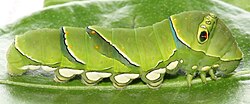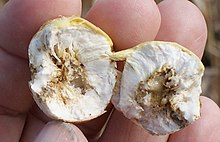A larva (plural larvae /ˈlɑːrviː) is a distinct juvenile form many animals undergo before metamorphosis into adults. Animals with indirect development such as insects, amphibians, or cnidarians typically have a larval phase of their life cycle.
Larva of Papilio xuthus, butterfly.
The larva's appearance is generally very different from the adult form (e.g. caterpillars and butterflies). A larva often has unique structures and organs that do not occur in the adult form, while their diet might be considerably different.
Larvae are frequently adapted to environments separate from adults. For example, some larvae such as tadpoles live almost exclusively in aquatic environments, but can live outside water as adult frogs. By living in a distinct environment, larvae may be given shelter from predators and reduce competition for resources with the adult population.
Eurosta solidaginis Goldenrod Gall Fly larva
Animals in the larval stage will consume food to fuel their transition into the adult form. In some species like barnacles, adults are immobile but their larvae are mobile, and use their mobile larval form to distribute themselves.
Some larvae are dependent on adults to feed them. In many eusocial Hymenoptera species, the larvae are fed by female workers. In Ropalidia marginata (a paper wasp) the males are also capable of feeding larvae but they are much less efficient, spending more time and getting less food to the larvae.
The larvae of some species (for example, some newts) can become pubescent and do not develop further into the adult form. This is a type of neoteny.
It is a misunderstanding that the larval form always reflects the group's evolutionary history. This could be the case, but often the larval stage has evolved secondarily, as in insects. In these cases the larval form may differ more than the adult form from the group's common origin.
Types of LarvaReferences
- Sen, R; Gadagkar, R (2006). "Males of the social wasp Ropalidia marginata can feed larvae, given an opportunity". Animal Behavior 71: 345–350. doi:10.1016/j.anbehav.2005.04.022.
- ^ Moore, R.C. (1959). Arthropoda I - Arthropoda General Features, Proarthropoda, Euarthropoda General Features, Trilobitomorpha. Treatise on Invertebrate Paleontology. Part O. Boulder, Colorado/Lawrence, Kansas: Geological Society of America/University of Kansas Press. pp. O121, O122, O125. ISBN 0-8137-3015-5
- Media related to Larva at Wikimedia Commons
 The dictionary definition of larva at Wiktionary
The dictionary definition of larva at Wiktionary- Arenas-Mena, C. (2010) Indirect development, transdifferentiation and the macroregulatory evolution of metazoans. Philosophical Transactions of the Royal Society B: Biological Sciences. Feb 27, 2010 Vol.365 no.1540 653-669
- Larva Season 1 Full HD
- Wikipedia







No comments:
Post a Comment